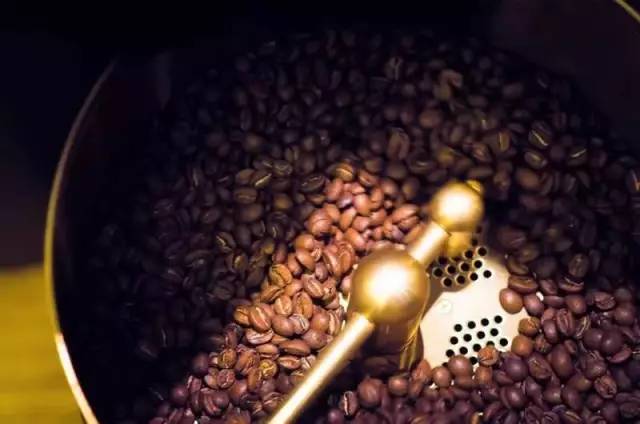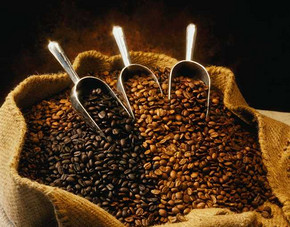Baking coffee is an exciting thing, not just in its color.
Follow the caf é (Wechat official account vdailycom) and found that Beautiful Cafe opened a small shop of its own.
Baking coffee is an exciting thing. It is reflected not only in its special color, but also in our painstaking efforts to make every coffee bean taste good. The color of baking can be imitated, but its special flavor cannot be imitated.

The Life of Coffee
The wonderful life journey of coffee beans begins when they are still lying in the bright red coffee fruit. It takes about five years from a coffee tree to produce harvested coffee fruit, and each tree produces the equivalent of a pound of roasted coffee beans a year. Before roasting these pebble-like coffee beans, coffee growers use natural or washing methods to treat the beans. By natural means, leave the ripe coffee fruit on the tree or on the ground to dry before the coffee fruit is shelled and peeled off. This method of washing is to peel the coffee beans from the coffee fruit, soak them in water, and then dry them on a spacious floor, or use modern equipment to dry them.
A brief introduction to the principle of Coffee Baking
First of all, after baking raw beans at more than 200 degrees Celsius, the moisture begins to evaporate, the volume expands by 60%, and the weight is reduced by 10% to 25. Depending on the degree of baking, the deeper the baking, the greater the weight loss. No wonder many operators do not like re-baking to save costs. Another important phenomenon is exhaust. Raw beans release carbon dioxide during baking and will continue to exhaust for 30 days after baking. Interestingly, carbon dioxide emissions contribute to the preservation of coffee beans, because during the exhaust process, oxygen molecules are not easy to invade, that is, the oxidation that destroys the flavor of coffee cannot be carried out, but the exhaust gradually slows down after seven days of baking. Oxygen molecules are easily attached to the bean surface, and the flavor of coffee decays quickly, which is an important reason why coffee beans are best used within a week after opening.
Achieve the highest caramel and least carbonization. Caramelization is a link that has the greatest impact on the flavor of coffee. After six to seven minutes of baking, raw beans absorb a lot of heat and start the pyrolysis reaction, resulting in the first explosive sound. Some sugars are converted into carbon dioxide, and water continues to evaporate. New aromatic components gradually develop into the so-called coffee oil. And combine with hundreds of aromatic substances such as nicotinic acid, citric acid, quinic acid, malic acid, acetic acid, caffeine and so on. Pyrolysis reaction can continue to the second explosion, although caramelization is an important process to awaken aromatic elves, but with the extension of baking time, some ingredients will also be carbonized to form a bad astringent bitter substance, how to obtain the highest caramelization, but also to minimize carbonization, which seems to be contradictory, but it is the biggest challenge for bakers.
Pay attention to the changes of sound, color and taste. The chemical reactions mentioned above can be judged by listening to the sound, seeing the color and smelling the smell. The color of coffee beans will change from gray to golden brown to light brown, then to reddish brown with a trace of oil, and then a large amount of oil to dark brown. If it continues to bake, the coffee oil on the bean surface will become dry, dead black, and emit a lot of blue smoke with a scorching smell. This is a warning that is close to ignition. Prepare to call 119 to help put out the fire. Experienced bakers will choose between light brown to oily dark brown for safety. Coffee beans change from shallow to deep because of changes in caramelization and acidity.
Listening to sound is also the basis for judging the degree of baking. If the temperature of the roaster is hot enough, coffee beans will burst twice during the roasting process. For example, high-temperature-resistant raw beans such as Mantenin and Angelica will burst for the first time in about seven minutes, and the sound will be low and sparse. This means that the "pyrolysis" is started, that is, the starch begins to be converted into caramel, and water is ejected from the bean surface with carbon dioxide, making a low burst sound, which is quiet for two minutes. At about 12 minutes, there was a more violent and sharp burst, which was the sound of broken fibers in coffee beans, which indicated that the baking was coming to an end, and the fragrance would fade if it went on. We can see that coffee beans can talk.
To sum up, coffee roasting is a science, and the age, density, hardness and moisture content of raw beans will affect the quality of roasted coffee. Even the relative humidity and temperature on the day of baking can not ignore the coffee beans that have just been baked. It is best to put the coffee beans for 2-5 days, so that it will be easier to drink after a large amount of carbon dioxide is discharged. Hong Kong coffee will choose an one-way breathable valve aluminum foil bag to preserve coffee beans, which can prevent air entry and cause oxidation, but also allow carbon dioxide emissions to ensure that coffee beans are kept in the best condition of freshness.
Important Notice :
前街咖啡 FrontStreet Coffee has moved to new addredd:
FrontStreet Coffee Address: 315,Donghua East Road,GuangZhou
Tel:020 38364473
- Prev

Household iron pot roasting coffee method tips sharing
Pay attention to the coffee comment (Weixin Official Accounts vdailycom ) and find that the beautiful cafe opens its own small shop. In fact, people in many European countries are roasting coffee with iron pots at home. What you need: a light frying pan with an airtight lid, or a heavy one if you want to do an aerobic workout, gas/electric stove, oven thermometer
- Next

Whether the roasting taste of coffee beans is correct or not, it is up to roasting.
Following Cafe (Wechat official account vdailycom) found that it is not so easy for a beautiful cafe to open its own small shop and have a good cup of coffee. From the beginning of the cultivation of coffee beans, each link may influence the taste of coffee. Among them, the most important step is to bake raw and ripe. From raw to ripe, from shallow to deep, to understand the baking characteristics of each stage to control the later stage of coffee.
Related
- Beginners will see the "Coffee pull flower" guide!
- What is the difference between ice blog purified milk and ordinary milk coffee?
- Why is the Philippines the largest producer of crops in Liberia?
- For coffee extraction, should the fine powder be retained?
- How does extracted espresso fill pressed powder? How much strength does it take to press the powder?
- How to make jasmine cold extract coffee? Is the jasmine + latte good?
- Will this little toy really make the coffee taste better? How does Lily Drip affect coffee extraction?
- Will the action of slapping the filter cup also affect coffee extraction?
- What's the difference between powder-to-water ratio and powder-to-liquid ratio?
- What is the Ethiopian local species? What does it have to do with Heirloom native species?

